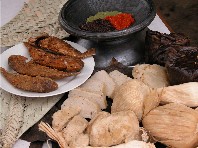Ghana-style Kenkey

Italy has polenta, Ghana has kenkey. This steamed fermented corn dough dish from Ghana has several versions. The two most well-known include Ga and Fanti styles, the former dough including salt and made of balls wrapped in corn husks before steaming, the latter without salt and wrapped in plantain leaves. It is also called komi in Ga, dokono in Twi, or dokon in Fante, kokui or tim in Ewe (sorry, I'm missing the correct orthography to insert special Akan characters in several of these words).
There are numerous other versions of kenkey, including a type where the skins of the corn are removed before grinding it. A sweet version is called dokompa, and it is one of the few instances where sugar is added to a main carbohydrate (sweet potatoes or yam are also added). Kenkey can also be made from plantains, where very ripe plantains are pounded and mixed with green plantain meal (amada kokonte). Plantain kenkey is known as brodokono in Twi, afanku in Ga, and ahyenku or asenku in Fante.
The preparation of corn-based kenkey involves souring the dough, then cooking half of it slightly to make aflatta, (a.k.a. ohu, or half-cooked banku), then mixing the partly cooked dough with the uncooked dough and wrapping and steaming the mixture. Banku is a smooth, softer dough that is cooked and stirred, rather than steamed.
Kenkey fascinates me, and I hope to continue tracing its history when I'm in Brazil later this year. Apparently some of the peoples in Amazonia, such as the Tupi-Guarani, also ferment corn to make dough. Many parts of sub-Saharan Africa have thick corn-based porridges (pap, bidia, ushima, sadza, ugali, etc.), but Ghana's fermented dough seems different. It is also difficult to duplicate in North America, where we are usually forced to ferment Indian Head or other (white) cornmeal. This disappoints on several counts: the corn should be soaked before being ground and fermented (something to do with how the starch changes to sugar, a food scientist in Ghana once tried to explain to me), it should be white (harder to find in the U.S.), and it should be finer than our stone ground cornmeal. I've also tried soaking dried Indian corn, and grinding it myself, but have not identified the correct types (flint, dent?) and been unsuccessful. Ga-style kenkey is wonderful with crisply fried fish, a spicy pepper sauce/sambal such as Ghana's "sheeto," and a fresh tomato, pepper, and onion "gravy."

